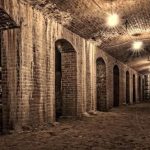 Music
Music  Music
Music  History
History 10 Less Than Jolly Events That Occurred on December 25
 Weird Stuff
Weird Stuff 10 Funny Ways That Researchers Overthink Christmas
 Politics
Politics 10 Political Scandals That Sent Crowds Into the Streets
 Weird Stuff
Weird Stuff Ten Bizarre Facts About The Doge Meme
 Our World
Our World 10 Ways Your Christmas Tree Is More Lit Than You Think
 Movies and TV
Movies and TV The 10 Coolest Stars to Set Sail on The Love Boat
 History
History 10 Things You Didn’t Know About the American National Anthem
 Technology
Technology Top 10 Everyday Tech Buzzwords That Hide a Darker Past
 Humans
Humans 10 Everyday Human Behaviors That Are Actually Survival Instincts
 Music
Music 10 Surprising Origin Stories of Your Favorite Holiday Songs
 History
History 10 Less Than Jolly Events That Occurred on December 25
 Weird Stuff
Weird Stuff 10 Funny Ways That Researchers Overthink Christmas
Who's Behind Listverse?

Jamie Frater
Head Editor
Jamie founded Listverse due to an insatiable desire to share fascinating, obscure, and bizarre facts. He has been a guest speaker on numerous national radio and television stations and is a five time published author.
More About Us Politics
Politics 10 Political Scandals That Sent Crowds Into the Streets
 Weird Stuff
Weird Stuff Ten Bizarre Facts About The Doge Meme
 Our World
Our World 10 Ways Your Christmas Tree Is More Lit Than You Think
 Movies and TV
Movies and TV The 10 Coolest Stars to Set Sail on The Love Boat
 History
History 10 Things You Didn’t Know About the American National Anthem
 Technology
Technology Top 10 Everyday Tech Buzzwords That Hide a Darker Past
 Humans
Humans 10 Everyday Human Behaviors That Are Actually Survival Instincts
10 Cool and Creepy Facts about the Nottingham Caves
The city of Nottingham in England is probably best known for the fictional hero and his friends who made the area their home. But as exciting as the tales of Robin Hood and his Merry Men are, the city also has a fascinating non-fictional history that stretches back centuries. Part of what makes it so intriguing is that Nottingham is really two cities—one above ground and the other below.
The latter is a labyrinth of caves, many of which were only discovered in recent decades, and the spooky secrets they hold are still being revealed. More might yet be discovered, but what is known about them so far is in this list. From a giant monastic fish tank to a murderous plot against a queen’s lover, here are ten curious and creepy facts about the Nottingham caves.
Related: 10 Shocking Things Found in a Cave
10 More Than 800 Caves
Almost 900 caves have been discovered lurking beneath the buildings and streets of Nottingham. Over 300 of them were found after 2014, which means that researchers have only recently started to see the full extent of this subterranean city. However, it was, of course, impossible to dig so many caves in secret. Written records show that Nottingham was known for its caves as many as 1,200 years ago when the Vikings roamed the British Isles.
One of the earliest references to the caves dates from AD 893 when a chronicler of King Alfred the Great used an old Welsh phrase, “Tiggua Cobauc,” meaning “house of caves,” to describe the city. In subsequent centuries, people started traveling to Nottingham to see the caves. Among them were literary figures like Daniel Defoe, who visited in the 1700s.
Most of the surviving caves, however, are not from the Viking era. The city’s resident archeologist estimates that there were probably only around 200 caves in medieval times, and they could have been destroyed or changed since then. The many caves that still exist were mainly dug between the 16th and 19th centuries.[1]
9 All Man-Made
One of the most surprising things about the Nottingham caves is that they are man-made. This begs the question of why so many people wanted a piece of underground real estate. The answer, in many cases, was storage. Both personal items and commercial goods were kept in the caves, many of which are little more than about ten feet or a few meters in length. The smallest ones are around 10 square feet (9 square meters). This is a decent size for storing goods, but surely too small for a person to spend much time in. Or so one would think.
Sadly, people have lived in the cramped caves at certain times. Unscrupulous landlords dealt with the massive rush of job seekers to the city during the Industrial Revolution by putting them up in caves. But are there no easier ways to make space than laboring away with a shovel? Why did Nottingham dig caves while other cities did not? It is because the city is built on soft but structurally stable sandstone. It is easy to dig and is sometimes so soft it can be carved away by hand, but it is strong enough not to collapse.[2]
8 Horrible Conditions
Living in the caves was outlawed in 1845, and it is no surprise that the government had to act; the conditions were truly dreadful. Little fresh air and sanitation, coupled with entire families cramped into tiny rooms, made it easy for diseases such as smallpox and cholera to thrive. Employers exploited those living in the caves, even using children from the subterranean slums for cheap labor.
One of these businesses was a tannery, which employed children as young as eight to make leather. The tanning process required ammonia, which was extracted from bodily waste. The smell was so foul that even rats stayed away, which, on the bright side, meant that one thing the cave-dwellers did not have to worry about was the bubonic plague.
The stench even warded off rodents above ground, which caused many wealthy people to move to the area during the plague years. But for the children below, not catching the Black Death or anything else meant work continued even as their hands wasted away from contact with the caustic quicklime used to strip the flesh from animal hides.[3]
7 Many Other Uses Too
Not all the caves’ uses over the years have been so nasty. Some surprisingly ordinary businesses in the city moved underground or operated out of caves dug into the side of cliffs. These included a post office, a drugstore, and a butchery. Some caves were also turned into a place where medieval people could do their business, known as a garderobe.
The security advantages of underground caves were not lost on the residents of Nottingham either. The founder of the city’s first bank dug several caves underneath his kitchen to keep people’s deposits safe, while caves beneath Nottingham Castle were turned into dungeons. But then there were also some bizarre uses, like a fish tank cave at a local monastery. This one is a bit more sensible than it sounds on the surface; fish were a dietary staple of medieval monks.
There are also a few elaborate caves that wealthy people would have used to hang out and show off. Another strange use, however, was the scientific study of tadpoles in the 19th century. Experiments were conducted in the caves to see how the little swimmers would develop without being exposed to light.[4]
6 A Queen’s Murdered Lover
Although innuendo is a key feature of the British sense of humor, there was probably no double meaning intended when they named one of the Nottingham caves “Mortimer’s Hole.” This is a tunnel that leads from Nottingham Castle to one of the oldest inns in England. The tunnel, built in 1067, came before the inn in 1189, so it was not planned to be an alcoholic noble’s sneaky shortcut to the pub.
In fact, Mortimer’s Hole takes its name not from a mere plan but a conspiracy. Roger Mortimer was the lover of Queen Isabella, and together, they forced her husband, King Edward II, to pass the crown to his teenage son so that they could rule until the young king came of age. However, by 1330, King Edward III saw that it was unlikely that his mother and Mortimer were simply going to hand over control.
One night, he and his men crept up the passage to the castle and captured Mortimer, who they later hanged. However, some experts think that the tunnel bearing Mortimer’s name is not the one Edward used. A different tunnel discovered in 2010 reportedly matched the historical records of the raid.[5]
5 An Ingenious Alarm System
Being located in Nottingham, the caves have predictably worked their way into the local folklore. According to legend, Robin Hood and his band of Merry Men used to hide out in them. Another sandstone cave in nearby Sherwood Forest is even called Robin Hood’s Cave. In reality, the popular tales about the Prince of Thieves are an amalgamation of several outlaws’ exploits, local gossip, and imagination, but the idea of him hanging out in the caves is probably not far off the mark.
A real-life—although often romanticized—outlaw highwayman, Dick Turpin, is believed to have hidden out in caves beneath Nottingham’s pubs to avoid capture. Some have suggested that a golf ball-sized hole in the ceiling of one of the surviving caves was used to warn criminals below that the authorities were in the area. A spotter could drop stones through it to alert them. Members of the Luddite movement are also believed to have used the caves to secretly plan the sabotage of textile machinery.[6]
4 A Safe Harbor from WWII Bombs
While they sometimes offered refuge to criminals, the Nottingham caves were also used to protect civilians. In the 20th century, new caves were created for this very purpose, and older ones were extended. This was so that they could be used as air raid shelters to protect people from bombings during World War II.
Nottingham was a large city and an ammunition manufacturing site during the Second World War, making it a likely target for German bombers. Almost 90 of the caves were converted into air raid shelters, and when the bombs finally fell on the city, they likely saved thousands of lives. The worst raid came in May 1941, setting the city ablaze, destroying its oldest church, and killing 159 people. Without the caves, the toll could have been much higher. Instead, life quickly went on, and local schools even reopened the next week.[7]
3 Got Beer?
One of the most popular uses of the caves, both today and historically, has been storing drinks. The cool temperature inside the caverns hardly varies from the ideal 57°F (14°C) throughout the year, making them great places for both storing and brewing beers and ales. For this reason, many pubs and inns around the city have their own caves.
As long ago as 1420, when Carmelite monks were the ones brewing the city’s ales, the water needed for the brewing process was drawn from wells inside the caves. Another cave brewery, dating back to 1785, was once the site of a happy accident when railway construction workers accidentally caused it to collapse and spill its contents into the tunnel they were digging.
However, the people of Nottingham were not brewing so much beer simply because the sandstone caves were good places to do it. There was a demand. Beer was widely drunk in medieval times, but not for the commonly heard reason that it was cleaner. It was seen as a more nutritious alternative, and the extra calories made it popular among workers and farmers.[8]
2 Haunted Tunnels
Creepy underground caves, criminal hideouts, dungeons—how could this city under a city not be haunted? Several of the caves have been places of alleged ghost sightings, while others have heard haunted sounds echoing inside the caverns. Mortimer’s Hole is one of these places, which, along with Nottingham Castle, is said to be haunted by the ghost of Queen Isabella, still distraught about the execution of her lover Roger Mortimer at the hands of her son. Those who see her in the cavernous passageway are said to hear her cry, “Fair son, have pity on gentle Mortimer.”
One of the city’s old inns is allegedly haunted by a ghostly young girl called Rosie, and guests leave her drinks, dolls, and marbles in a dark corner. Nighttime ghost tours of the caves are popular with visitors to the city, and several sightings have been reported of a crying Victorian woman roaming around in the darkness. Others have mysteriously been hit by stones.[9]
1 Still Used Today
Ghost tours are only one of the many ways the caves are still used today. While some are kept open to educate the public about Nottingham’s history, many are privately owned and have been adapted for all sorts of things. Hundreds of years ago, Christian monks turned caves into chapels, but more recently, Buddhist monks have used the caves to practice and teach meditation. Although it is not unusual for them to spend years in isolated places like caves, the monks added that they recommended that the public only spend a few hours.
Another longtime use of the caves has been leisure activities. Evidence shows that some have been used as bowling alleys and even men’s clubs. This trend continues, with some pubs and restaurants now seating patrons inside caves. Some caves are now also used to seat audiences for unique theatrical productions, and there is even a cave escape room for those who are brave enough.[10]








